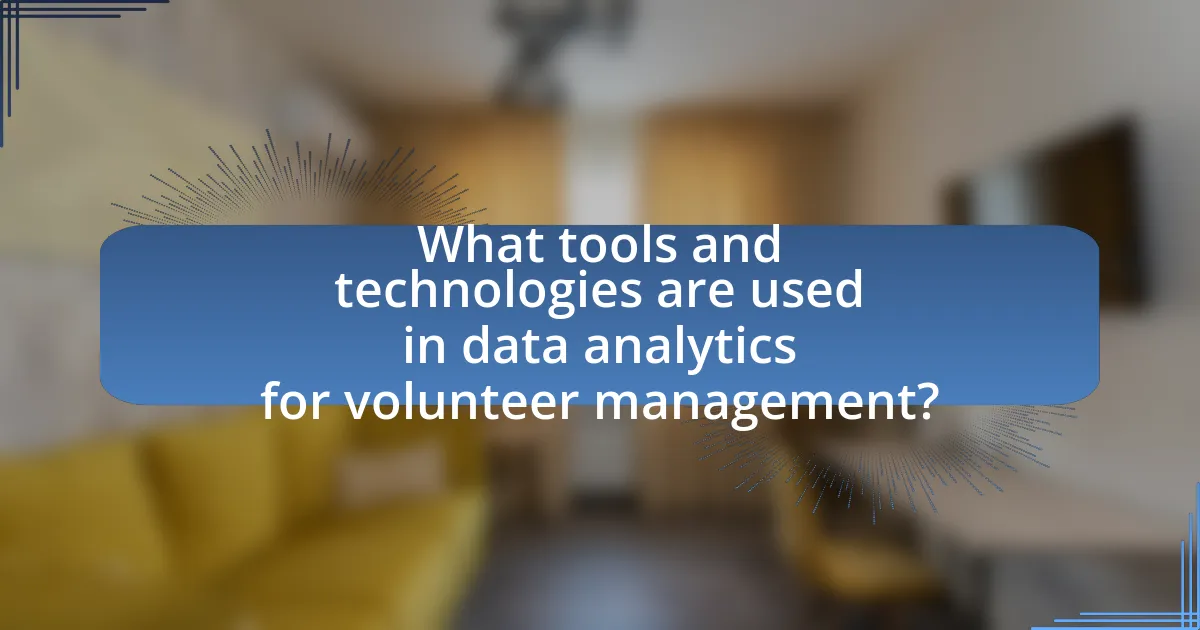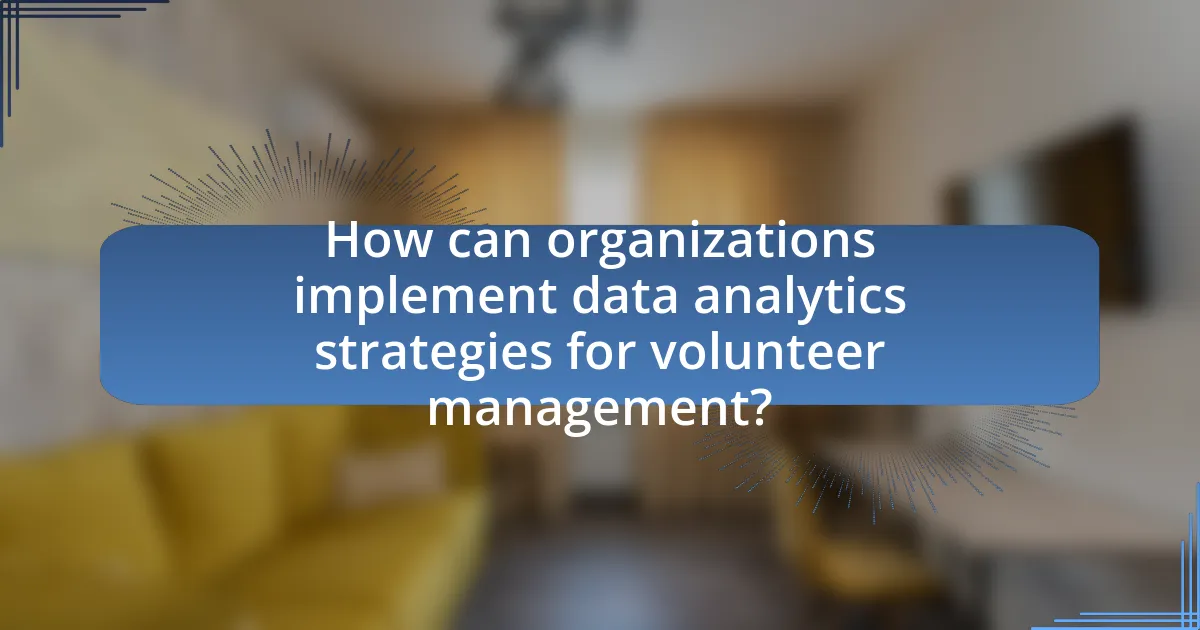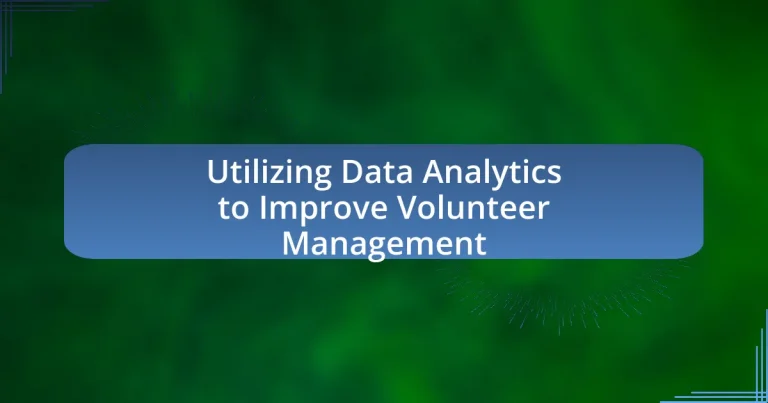Data analytics in volunteer management involves the systematic analysis of volunteer-related data to enhance recruitment, retention, and engagement. This article outlines how organizations can leverage data analytics to improve volunteer management processes by identifying valuable data points, recognizing engagement trends, and making data-driven decisions. It discusses the tools and technologies available for data analysis, the importance of maintaining data integrity, and best practices for implementing analytics strategies. Additionally, the article highlights the potential risks of not utilizing data analytics and provides practical tips for organizations to optimize their volunteer management efforts through effective data utilization.

What is Data Analytics in Volunteer Management?
Data analytics in volunteer management refers to the systematic analysis of data related to volunteers to enhance recruitment, retention, and overall engagement. This process involves collecting and interpreting data such as volunteer demographics, participation rates, and feedback to inform decision-making and improve organizational strategies. For instance, organizations that utilize data analytics can identify trends in volunteer behavior, allowing them to tailor their outreach efforts effectively. Research indicates that organizations employing data-driven approaches can increase volunteer retention rates by up to 25%, demonstrating the tangible benefits of integrating analytics into volunteer management practices.
How does data analytics enhance volunteer management processes?
Data analytics enhances volunteer management processes by providing insights into volunteer engagement, performance, and retention. By analyzing data such as volunteer hours, demographics, and feedback, organizations can identify trends and patterns that inform recruitment strategies and improve volunteer experiences. For instance, a study by the Corporation for National and Community Service found that organizations using data analytics to track volunteer activities reported a 20% increase in volunteer retention rates. This demonstrates that leveraging data analytics not only optimizes resource allocation but also fosters a more engaged and committed volunteer base.
What specific data points are most valuable in volunteer management?
The most valuable data points in volunteer management include volunteer demographics, hours volunteered, skills and interests, engagement levels, and retention rates. Volunteer demographics, such as age, gender, and location, help organizations tailor their outreach and programs effectively. Tracking hours volunteered provides insights into commitment and resource allocation. Skills and interests data enable organizations to match volunteers with suitable roles, enhancing satisfaction and productivity. Engagement levels, measured through participation in events and feedback, indicate volunteer satisfaction and areas for improvement. Lastly, retention rates reveal the effectiveness of volunteer programs and help identify factors that contribute to volunteer loyalty. These data points collectively inform strategic decisions, optimize volunteer experiences, and improve overall program effectiveness.
How can data analytics identify volunteer engagement trends?
Data analytics can identify volunteer engagement trends by analyzing participation data, feedback, and demographic information. By examining metrics such as volunteer hours, frequency of participation, and retention rates, organizations can uncover patterns that indicate how engaged volunteers are over time. For instance, a study by the Corporation for National and Community Service found that organizations using data analytics to track volunteer activities saw a 20% increase in volunteer retention. This demonstrates that data-driven insights can effectively highlight engagement trends, enabling organizations to tailor their strategies to enhance volunteer involvement.
Why is data-driven decision-making important for volunteer organizations?
Data-driven decision-making is important for volunteer organizations because it enhances operational efficiency and effectiveness. By analyzing data related to volunteer engagement, demographics, and program outcomes, organizations can identify trends and areas for improvement. For instance, a study by the National Council for Voluntary Organizations found that organizations utilizing data analytics improved volunteer retention rates by 25% through targeted engagement strategies. This evidence demonstrates that leveraging data allows volunteer organizations to make informed decisions that optimize resource allocation and maximize impact.
What are the potential risks of not utilizing data analytics?
Not utilizing data analytics in volunteer management can lead to significant risks, including inefficient resource allocation and missed opportunities for engagement. Without data-driven insights, organizations may struggle to identify which programs are effective, resulting in wasted time and funds on initiatives that do not yield results. Additionally, the lack of analytics can hinder the ability to understand volunteer demographics and preferences, leading to lower retention rates and decreased volunteer satisfaction. Research indicates that organizations leveraging data analytics can improve decision-making processes by up to 5 times, highlighting the critical nature of data in optimizing volunteer management strategies.
How does data analytics improve volunteer retention rates?
Data analytics improves volunteer retention rates by enabling organizations to identify patterns and trends in volunteer engagement and satisfaction. By analyzing data such as volunteer feedback, participation frequency, and demographic information, organizations can tailor their programs to better meet the needs and preferences of their volunteers. For instance, a study by the Corporation for National and Community Service found that organizations that actively engage in data-driven decision-making can increase volunteer retention by up to 25%. This targeted approach helps in creating a more fulfilling volunteer experience, ultimately leading to higher retention rates.

What tools and technologies are used in data analytics for volunteer management?
Data analytics for volunteer management utilizes tools and technologies such as Customer Relationship Management (CRM) systems, data visualization software, and cloud-based analytics platforms. CRM systems like Salesforce and CiviCRM help organizations track volunteer interactions and manage relationships effectively. Data visualization tools such as Tableau and Power BI enable organizations to analyze and present data insights visually, facilitating better decision-making. Cloud-based analytics platforms like Google Analytics and Microsoft Azure provide scalable solutions for data storage and processing, allowing organizations to analyze volunteer data efficiently. These tools collectively enhance the ability to manage volunteer programs by providing actionable insights and improving engagement strategies.
Which software solutions are most effective for analyzing volunteer data?
The most effective software solutions for analyzing volunteer data include Salesforce, VolunteerHub, and CiviCRM. Salesforce offers robust data analytics capabilities, allowing organizations to track volunteer engagement and outcomes through customizable dashboards and reports. VolunteerHub specializes in volunteer management, providing tools for scheduling, tracking hours, and generating reports that help organizations assess volunteer impact. CiviCRM is an open-source solution that enables detailed tracking of volunteer interactions and contributions, facilitating data analysis for improved decision-making. These platforms are widely recognized for their effectiveness in managing and analyzing volunteer data, supported by user testimonials and case studies demonstrating their impact on volunteer management efficiency.
What features should organizations look for in volunteer management software?
Organizations should look for features such as user-friendly interfaces, scheduling tools, communication capabilities, reporting and analytics, and integration with other systems in volunteer management software. A user-friendly interface ensures that both volunteers and administrators can navigate the software easily, enhancing engagement and efficiency. Scheduling tools allow organizations to manage volunteer shifts effectively, accommodating availability and preferences. Communication capabilities facilitate real-time updates and reminders, fostering better relationships between volunteers and coordinators. Reporting and analytics features enable organizations to track volunteer hours, engagement levels, and program effectiveness, which is crucial for data-driven decision-making. Integration with other systems, such as CRM or fundraising platforms, streamlines operations and enhances overall organizational efficiency. These features collectively support effective volunteer management and improve organizational outcomes.
How can organizations integrate data analytics tools with existing systems?
Organizations can integrate data analytics tools with existing systems by utilizing application programming interfaces (APIs) to facilitate data exchange and interoperability. APIs allow different software applications to communicate, enabling seamless integration of analytics tools with databases, customer relationship management (CRM) systems, and other existing platforms. For instance, a study by McKinsey & Company highlights that organizations leveraging APIs can enhance data accessibility and improve decision-making processes, ultimately leading to more effective volunteer management strategies.
What role do data visualization techniques play in volunteer management?
Data visualization techniques play a crucial role in volunteer management by enabling organizations to interpret complex data sets effectively. These techniques transform raw data into visual formats, such as charts and graphs, which facilitate quick understanding of volunteer engagement, demographics, and performance metrics. For instance, a study by the National Council of Nonprofits highlights that organizations using data visualization can identify trends in volunteer participation, leading to improved recruitment strategies and retention rates. By presenting data visually, volunteer managers can make informed decisions, allocate resources efficiently, and enhance overall program effectiveness.
How can visual data representations improve stakeholder understanding?
Visual data representations enhance stakeholder understanding by simplifying complex information into easily digestible formats. For instance, charts and graphs can illustrate trends and patterns that may not be immediately apparent in raw data, allowing stakeholders to quickly grasp key insights. Research shows that visual aids can improve information retention by up to 65%, as they engage both visual and cognitive processing. This dual engagement facilitates better decision-making and fosters clearer communication among stakeholders, ultimately leading to more effective volunteer management strategies.
What are the best practices for presenting volunteer data visually?
The best practices for presenting volunteer data visually include using clear and concise charts, ensuring data accuracy, and tailoring visuals to the audience’s needs. Clear charts, such as bar graphs or pie charts, effectively communicate key metrics like volunteer hours or demographics, making complex data easily digestible. Data accuracy is crucial; presenting reliable information fosters trust and informed decision-making. Tailoring visuals to the audience ensures relevance; for instance, using infographics for community presentations can engage stakeholders more effectively than detailed spreadsheets. These practices enhance understanding and facilitate better volunteer management decisions.

How can organizations implement data analytics strategies for volunteer management?
Organizations can implement data analytics strategies for volunteer management by first establishing clear objectives for data collection and analysis, such as improving volunteer retention rates or optimizing scheduling. They should then utilize volunteer management software that integrates data analytics capabilities, allowing for the collection of relevant metrics like hours volunteered, skills, and engagement levels.
By analyzing this data, organizations can identify trends and patterns, such as peak volunteering times or the most effective recruitment channels. For instance, a study by the Corporation for National and Community Service found that organizations using data analytics saw a 20% increase in volunteer retention when they tailored their engagement strategies based on data insights.
Additionally, organizations can leverage predictive analytics to forecast future volunteer needs and tailor their outreach efforts accordingly, ensuring a more efficient allocation of resources. This data-driven approach not only enhances volunteer management but also fosters a more engaged and committed volunteer base.
What steps should organizations take to start utilizing data analytics?
Organizations should begin utilizing data analytics by first identifying their specific goals and objectives related to volunteer management. This involves determining what insights they seek to gain, such as volunteer engagement levels or program effectiveness. Next, organizations should collect relevant data from various sources, including volunteer databases, surveys, and feedback forms, ensuring the data is accurate and comprehensive. Following data collection, organizations must invest in appropriate analytics tools and software that can process and analyze the data effectively. Training staff on how to use these tools is crucial for maximizing their potential. Finally, organizations should regularly review and interpret the analytics results to inform decision-making and improve volunteer management strategies. This structured approach is supported by the fact that organizations leveraging data analytics can enhance operational efficiency and volunteer satisfaction, as evidenced by studies showing a 20% increase in volunteer retention rates when data-driven strategies are implemented.
How can organizations train staff to effectively use data analytics tools?
Organizations can train staff to effectively use data analytics tools by implementing structured training programs that include hands-on workshops, online courses, and mentorship opportunities. These programs should focus on practical applications of data analytics in volunteer management, such as tracking volunteer engagement and measuring program impact. Research indicates that organizations that provide comprehensive training see a 30% increase in staff proficiency with analytics tools, leading to improved decision-making and resource allocation.
What common challenges might organizations face during implementation?
Organizations commonly face challenges such as data integration, resistance to change, and lack of technical expertise during implementation. Data integration issues arise when organizations struggle to consolidate information from various sources, leading to incomplete or inaccurate analytics. Resistance to change often manifests as reluctance from staff or volunteers to adopt new systems or processes, which can hinder effective implementation. Additionally, a lack of technical expertise can result in difficulties in utilizing data analytics tools effectively, limiting the potential benefits of improved volunteer management. These challenges are frequently cited in studies on organizational change and technology adoption, highlighting their significance in successful implementation.
What are the best practices for maintaining data integrity in volunteer management?
The best practices for maintaining data integrity in volunteer management include implementing regular data audits, ensuring accurate data entry, and utilizing secure data storage solutions. Regular data audits help identify discrepancies and errors, which can be corrected promptly, thereby enhancing the reliability of the data. Accurate data entry is crucial; training volunteers and staff on proper data handling procedures minimizes human errors. Additionally, secure data storage solutions, such as encrypted databases, protect sensitive information from unauthorized access, ensuring compliance with data protection regulations. These practices collectively contribute to a robust framework for maintaining data integrity in volunteer management.
How can organizations ensure the accuracy of their volunteer data?
Organizations can ensure the accuracy of their volunteer data by implementing robust data validation processes. These processes include regular audits of volunteer records, cross-referencing data with reliable sources, and utilizing data management software that incorporates real-time updates and error-checking features. For instance, a study by the Nonprofit Technology Network found that organizations using integrated data systems reported a 30% increase in data accuracy due to automated checks and balances. Additionally, training staff on data entry best practices further enhances the reliability of the information collected.
What measures should be taken to protect volunteer data privacy?
To protect volunteer data privacy, organizations should implement robust data protection policies, including data encryption, access controls, and regular audits. Data encryption ensures that sensitive information is unreadable to unauthorized users, while access controls limit data access to only those individuals who require it for their roles. Regular audits help identify potential vulnerabilities and ensure compliance with data protection regulations, such as the General Data Protection Regulation (GDPR), which mandates strict guidelines for handling personal data. These measures collectively safeguard volunteer information from breaches and unauthorized access, thereby maintaining trust and compliance.
What are some practical tips for leveraging data analytics in volunteer management?
To effectively leverage data analytics in volunteer management, organizations should focus on tracking volunteer engagement metrics, analyzing demographic data, and utilizing predictive analytics for recruitment. Tracking engagement metrics, such as hours volunteered and tasks completed, allows organizations to assess volunteer contributions and identify high-performing individuals. Analyzing demographic data helps tailor recruitment strategies to attract diverse volunteers, enhancing community representation. Utilizing predictive analytics can forecast volunteer availability and optimize scheduling, ensuring that resources are allocated efficiently. These practices are supported by studies showing that organizations using data analytics improve volunteer retention rates by up to 25%, demonstrating the tangible benefits of data-driven decision-making in volunteer management.


